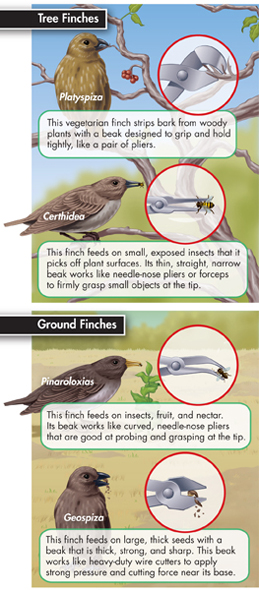VISUAL ANALOGY
FINCH BEAK TOOLS
Darwin noted that several finch species have beaks of very different sizes and shapes. Each species uses its beak like a specialized tool to pick up and handle its food, as shown in Figure 16–17. Darwin proposed that natural selection had shaped the beaks of different bird populations as they became adapted to eat different foods. That was a reasonable hypothesis. But was there any way to test it? No one thought there was a way until Peter and Rosemary Grant of Princeton University came along.
The Grants have spent more than 35 years studying Galápagos finches. They realized that Darwin's hypothesis rested on two testable assumptions. First, for beak size and shape to evolve, there must be enough heritable variation in those traits to provide raw material for natural selection. Second, differences in beak size and shape must produce differences in fitness.
The Grants have tested these hypotheses on the medium ground finch (Geospiza) on the island of Daphne Major. This island is large enough to support good-sized finch populations, yet small enough to allow the Grants to catch, tag, and identify nearly every bird of the species.
During their study, the Grants periodically recapture the birds. They record which individuals are alive and which have died, which have reproduced and which have not. For each individual, the Grants record anatomical characteristics like wing length, leg length, beak length, beak depth, beak color, feather colors, and total mass. The data the Grants have recorded show that there is indeed great variation of heritable traits among Galápagos finches.
Natural Selection The Grants' data have shown that individual finches with different-size beaks have better or worse chances of surviving both seasonal droughts and longer dry spells. When food becomes scarce during dry periods, birds with the largest beaks are more likely to survive, as shown in Figure 16–18. As a result, average beak size in this finch population has increased dramatically.  The Grants have documented that natural selection takes place in wild finch populations frequently, and sometimes rapidly. Changes in food supply created selection pressure that caused finch populations to evolve within decades. This evolutionary change occurred much faster than many researchers thought possible.
The Grants have documented that natural selection takes place in wild finch populations frequently, and sometimes rapidly. Changes in food supply created selection pressure that caused finch populations to evolve within decades. This evolutionary change occurred much faster than many researchers thought possible.
Table of Contents
- Formulas and Equations
- Applying Formulas and Equations
- Mean, Median, and Mode
- Estimation
- Using Measurements in Calculations
- Effects of Measurement Errors
- Accuracy
- Precision
- Comparing Accuracy and Precision
- Significant Figures
- Calculating With Significant Figures
- Scientific Notation
- Calculating With Scientific Notation
- Dimensional Analysis
- Applying Dimensional Analysis





